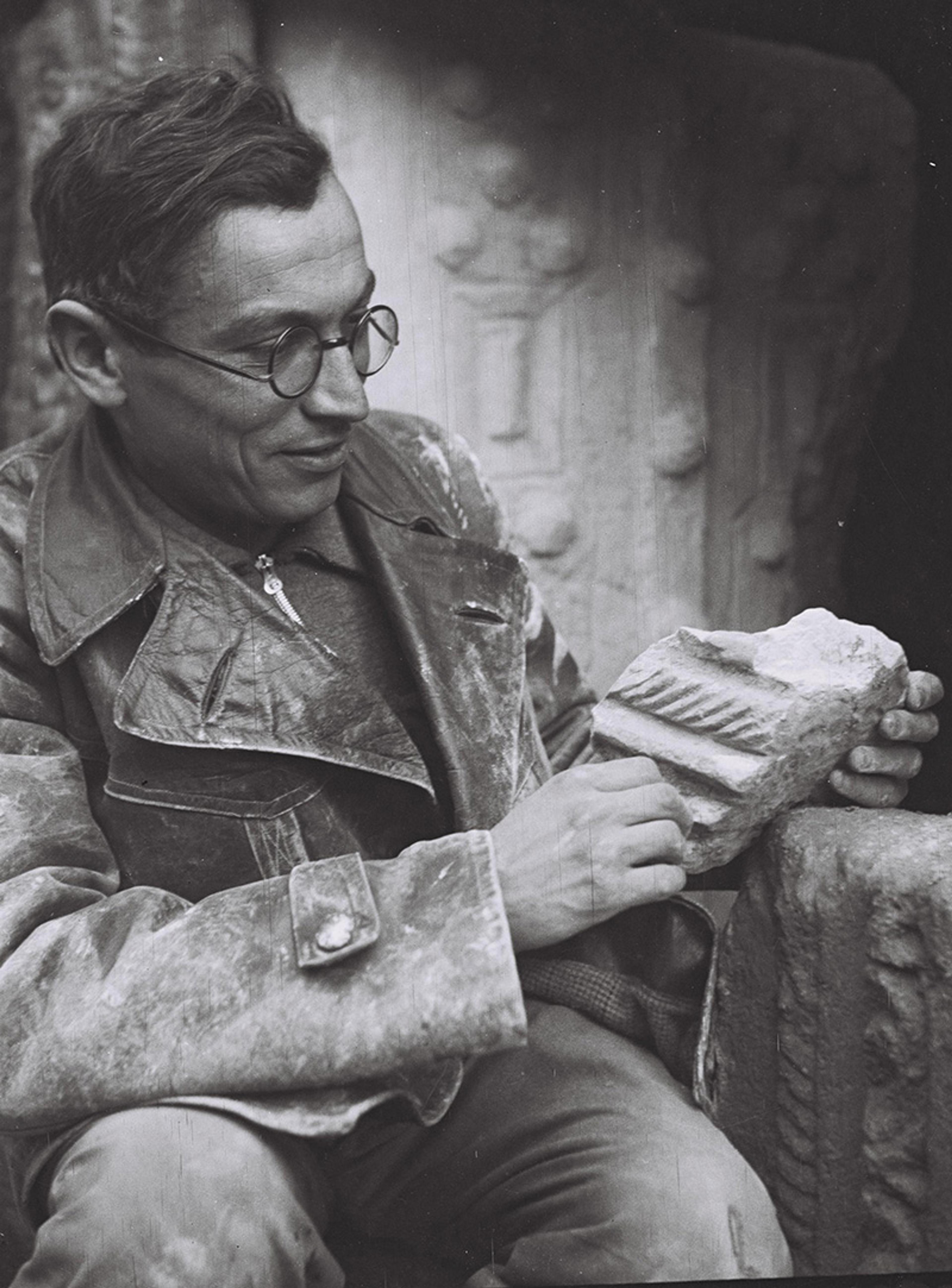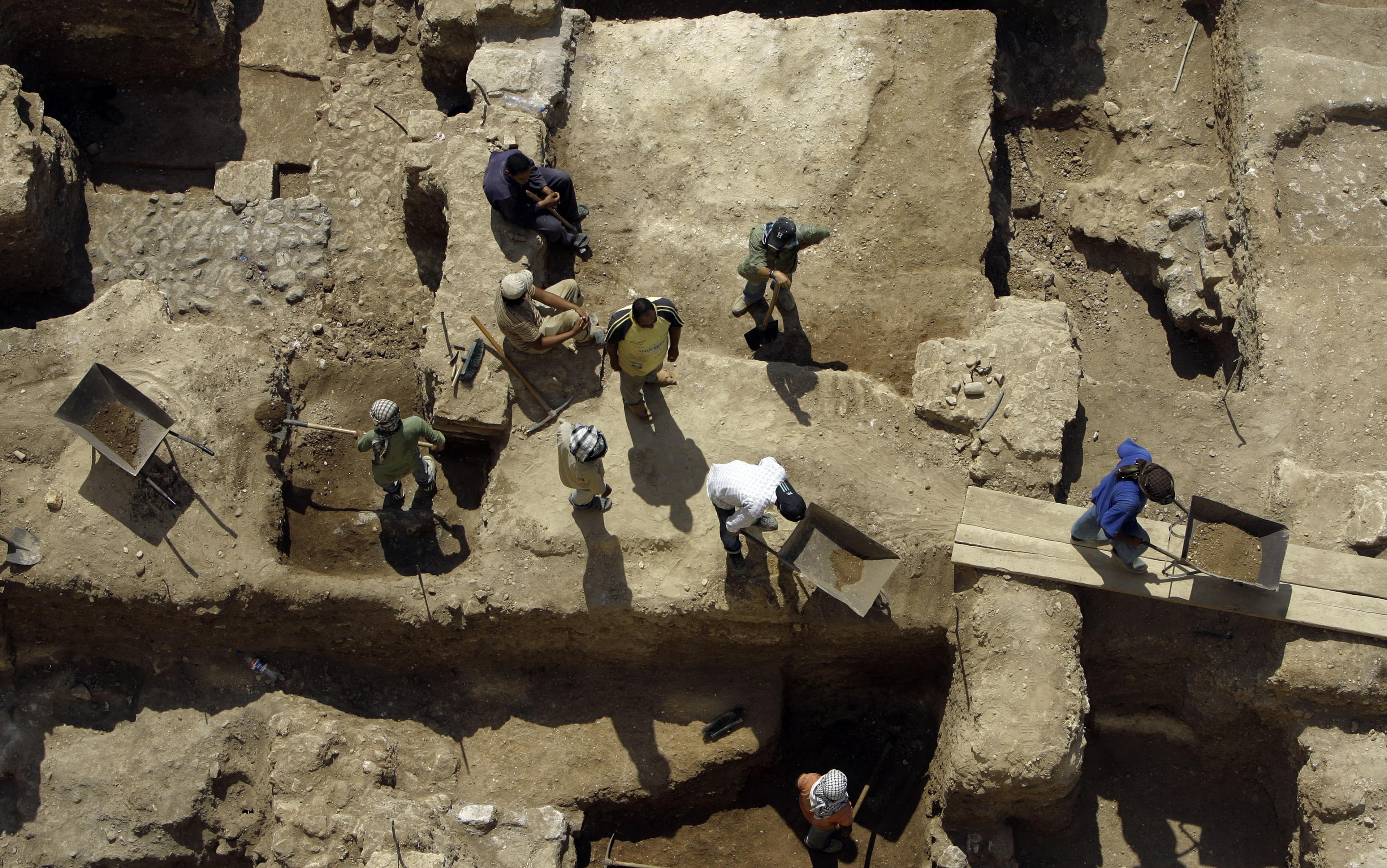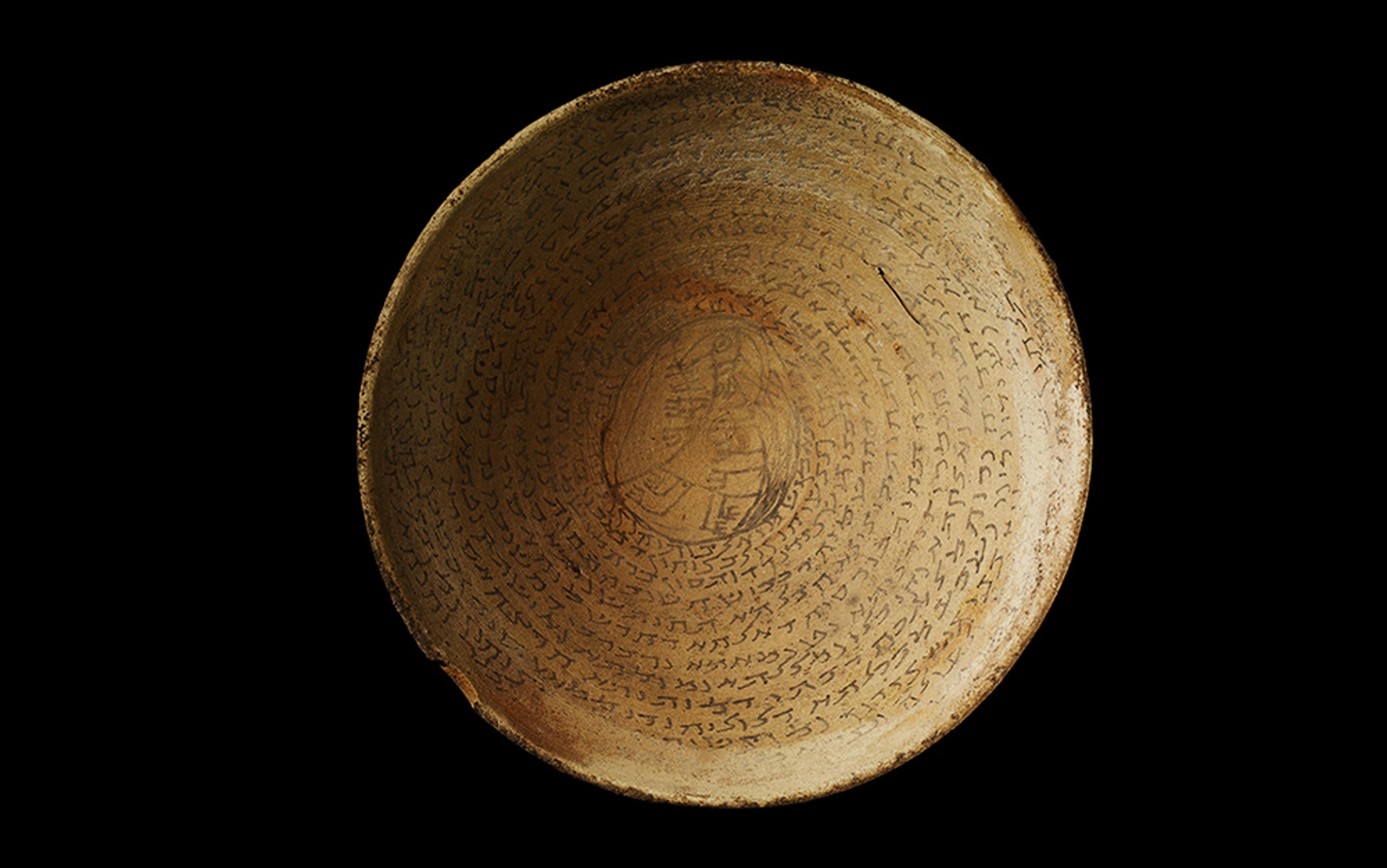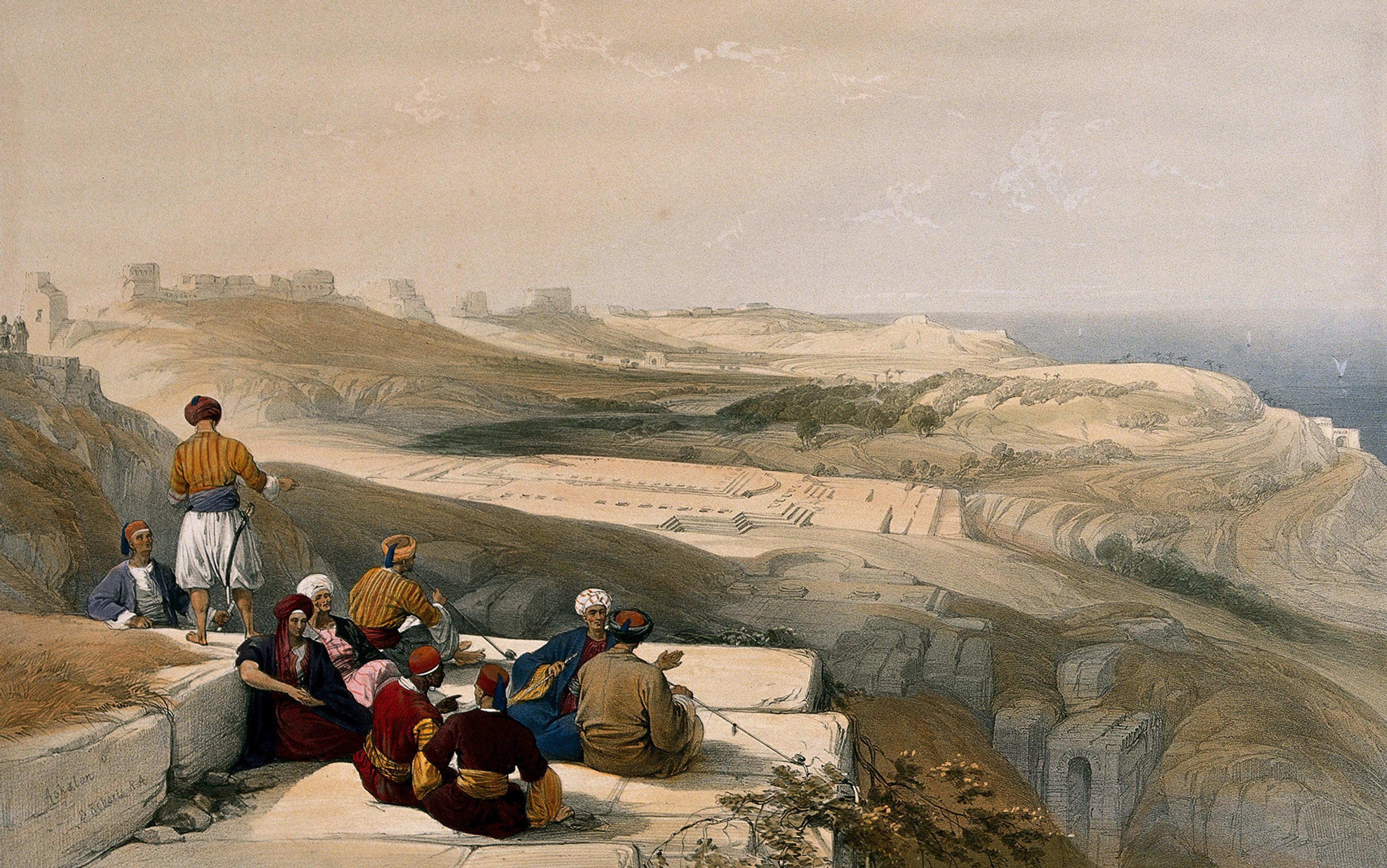One day in 2017, the archaeologist Eilat Mazar asked her colleague Haggai Misgav to stop by her office at the Hebrew University of Jerusalem. ‘She closed the door, opened a locker, and said: “Read this!”’ Mazar handed him a tiny piece of rounded and flattened clay, broken on one side and no larger than his thumbnail; he saw that it had distinct markings on its surface.
Misgav, who specialises in ancient inscriptions, glanced at what he recognised were archaic Semitic letters. ‘It says “Isaiah” – a common name,’ he told her. Then Mazar handed him a magnifying glass. He peered more closely at other markings below the name. ‘It looks like the word “prophet”,’ he added.
‘That,’ said Mazar, ‘was why I called you in!’
She explained that the small oval of clay had been recovered in a 2,700-year-old garbage pit at the foot of Jerusalem’s acropolis – what Jews call the Temple Mount, and Muslims refer to as the Noble Sanctuary. The artefact was found less than a dozen feet from another clay lump that had been stamped with the personal seal of King Hezekiah. That Judean monarch is mentioned in the Bible as the 13th leader in a lineage that began with David.
According to scripture, Hezekiah and Isaiah not only lived at the same time – the 8th century BCE – but they had a stormy relationship. In one passage, when the ruler was deathly ill, the prophet told him it was a curse sent by God for his failure to marry. Hezekiah promptly recovered when he married Isaiah’s daughter.
Uncovering the men’s personal stamps, which are akin to modern signatures, in such close proximity would bring to life a pair of famous figures from the Hebrew Bible, what Christians call the Old Testament. If the seal she showed to Misgav did indeed read ‘Belonging to Isaiah the prophet’, as she believed, then Mazar had found the first physical evidence for one of Judaism’s most important prophets, as well as that of Hezekiah himself.
By this time, Mazar was already arguably the world’s most renowned biblical archaeologist. Her Jerusalem discoveries were legion. In 2005, she had uncovered what she argued was the palace of King David, and went on to pinpoint remains that she believed were the quarters of his successor and son, Solomon. She had also found evidence for the wall built by Nehemiah after the Judean elite returned from Babylonian captivity in the 6th century BCE. One particularly surprising discovery was that of a golden medallion featuring a menorah from the height of Christian Byzantium in the 7th century CE. And she had unearthed an array of other seal impressions linked to individuals also mentioned in the Bible.

The archaeologist Eilat Mazar in 2010. Photo by Gil Cohen Magen/Reuters
On closer analysis, however, Misgav began to have grave doubts about his first reading. The word he had initially read as ‘prophet’ was broken off and missing a key letter. He became convinced that a far more likely reading was that of a personal name unrelated to the religious seer. He also noted that seals from that era were typically used only by businessmen or government officials. Misgav estimated there was less than a one-in-five chance that the impression in clay was made by a seal owned by the famous Isaiah.
He relayed his concerns to Mazar, who nonetheless published the article ‘Is This the Prophet Isaiah’s Signature?’ (2018). While she acknowledged the missing letter and admitted that it was ‘speculative’ to assign the seal impression to Isaiah the prophet, Mazar insisted that its proximity to the Hezekiah seal impression was important circumstantial evidence. She ended on an upbeat note, concluding that the find ‘leads us to consider the personality and the proximity of the prophet Isaiah as one of the closest advisors to King Hezekiah’.
That Bible-as-guidebook approach fell from favour among academics long ago
Predictably, her announcement drew extensive media coverage. Discovering a seal matching the name of figures mentioned in an old Egyptian or Mesopotamian text typically would cause a stir only in limited scholarly circles. But given there are 15 million Jews and 2.5 billion Christians, a find directly related to well-known characters in the Bible can immediately generate widespread international publicity.
While much of that reporting mentioned the academic parsing of ancient Semitic letters, the discovery was greeted by many as the latest example of archaeology confirming a passage in the Bible. One Israeli publication, for example, brushed aside the letter controversy by naming it the top biblical archaeology find of 2018, while an online exhibit by the evangelical Christian college in Oklahoma that supported Mazar’s dig proclaimed: ‘Seals of Isaiah and King Hezekiah Discovered’. Though technically correct – there was no question the seal was that of a man named Isaiah – this statement was at best misleading.
Mazar’s career was cut short when she died this May, aged 64, leaving a legacy of notable finds and an impressive publication record. Up until the end of her life, she remained one of the last university scientists digging with a spade in one hand and a Bible in the other, eager to uncover clues to the people and places described in scripture.
That Bible-as-guidebook approach fell from favour among academics long ago. Excavators today are generally less enamoured of unearthing royal tombs and ancient shrines than with determining what people ate, with whom they traded, and how their material culture changed over time. Yet the Hebrew holy book continues to exert a peculiar hold over Israeli archaeology. That pull is directly related to the furious political and religious struggle that roils a city held in esteem by billions of people of different faiths, and claimed as the capital of two distinct peoples. Mazar’s passing marks the end of a long era, but it is unlikely to alter that stark reality.
American Protestant clerics launched the field of biblical archaeology nearly two centuries ago, when holy writ was under attack from the revolutionary ideas generated by geology and biology. They seized on the new tools of excavation to combat growing scepticism about Christian ideas on the origins of Earth and humans. That singular mission morphed into a desire to pinpoint places mentioned in the Bible and to confirm the events and people familiar to its readers.
Starting in the 1830s, biblical explorers flocked to the Holy Land and Jerusalem with their compasses, shovels, and well-thumbed copies of the Good Book as their all-purpose guide.
In the early decades of Near Eastern archaeology, ancient texts such as the Bible played a critical role in forwarding research. Thanks to the Rosetta Stone, Egyptian hieroglyphics were deciphered in the 1820s, opening a door to a civilisation that until then was poorly understood. Later scholars cracked the code of the cuneiform writing of Mesopotamian empires such as Babylon and Assyria, providing a wealth of data on those societies.
Over time, however, archaeologists grasped that Near Eastern rulers, priests and scribes were apt to exaggerate and even make up historical events to suit their political and religious needs. Archaeologists confirmed, for example, that the mythical Sumerian figure of Gilgamesh was, in fact, king of the ancient Sumerian city of Uruk. But they did not have to take literally the well-known story of his discovery of the secret of immortality.
Ben-Gurion looked to the Bible much as Americans look to the Declaration of Independence
The Bible, of course, was no exception. Yet since it was taken literally by many Protestants, biblical archaeologists were slow to confront the contradictions and even fabrications that riddle the text. By the Second World War, academics had come to chafe at what they saw as strained efforts by devout Christian scholars to align their finds with the word of God.
Then came the creation of the state of Israel in 1948. The first generation of Israeli Jewish archaeologists fanned across the land, many of them searching for evidence of ancestors described in the Bible. Unlike their American and European predecessors, who often were Christian clergy, these excavators were typically Zionist and secular. They shared the view of Israel’s first prime minister, David Ben-Gurion, who looked to the Bible much as Americans look to the Declaration of Independence or the Constitution, as the very foundation of national life.
When Israel conquered East Jerusalem, including the Old City with its many religious sites, in the Six-Day War in 1967, the country’s archaeologists gained access to the heart of the Holy Land that had long been under Jordanian occupation. One of the largest subsequent digs took place just south of the Western Wall Plaza, in an area that was created when Israeli bulldozers demolished a medieval Arab quarter.
The man who led the excavation was hailed as the dean of Israel’s biblical archaeologists. Benjamin Mazar, grandfather to Eilat, was a Polish-born immigrant educated in prewar Germany who received Israel’s first dig permit. He went on to become president and rector of the premier institution of higher learning at the time, the Hebrew University of Jerusalem. Digging at the foot of the city’s acropolis, his team uncovered early Islamic palaces and Roman homes.

Benjamin Mazar, Eilat’s grandfather, in 1936. Photo courtesy Wikipedia
But public imagination was especially captured by what lay below. The excavation revealed monumental buildings from the Judean metropolis in the century before the Roman destruction of 70 CE. For many Israeli Jews, Benjamin Mazar’s discoveries provided physical evidence backing Israel’s claim to Jerusalem as its ‘eternal capital’.
The 10-year-old Eilat Mazar worked on her grandfather’s dig, and each weekend she served coffee to leading Israeli academics and politicians who gathered in her grandfather’s living room. The younger Mazar went on to study archaeology at Hebrew University, and spent much of her time researching a Phoenician cemetery in northern Israel. She returned to Jerusalem for good in 1981 to assist in a dig led by a former Israeli paratrooper-turned-archaeologist named Yigal Shiloh.
While the elder Mazar had uncovered the Judean Jerusalem under Herod the Great, Shiloh hoped to find the city captured by David and embellished by his son Solomon 1,000 years earlier. Archaeologists had long believed this City of David – the original core of the city – lay outside the walls of the Old City, on a rocky spur of land extending south from the city’s acropolis. Biblical accounts suggested that Jerusalem in that era was an impressive city that became the centre of a short-lived empire, but excavators had yet to find any sign of early Israelite occupation. After a half-dozen years of intensive excavations, Shiloh uncovered impressive ruins, but most appeared to date to previous eras in which Canaanites dominated or to later centuries.
This absence of evidence was more than a scientific puzzle. It was also a political embarrassment. Israel had incorporated the ridge, along with the rest of East Jerusalem, into the borders of its national capital. What Israeli Jews called the City of David was a crowded Palestinian village that Arabs called Wadi Hilweh. Right-wing Jewish groups sought to settle Jews on the ridge, and tensions between the two peoples sparked occasional violence. Lacking concrete proof of the glory days of David and Solomon, Israel’s claims to the ridge rang hollow.
He argued that David was little more than a tribal chieftain, and Jerusalem a scruffy mountaintop village
This gap in Jerusalem’s history gnawed at the younger Mazar. ‘This lack of evidence encouraged the argument that, in the time of David and Solomon, the city didn’t exist as the Bible said,’ she explained. She and her grandfather collaborated in 1986 on a small dig just to the north, near the southern wall of the Temple Mount, but failed to find material that could be attributed to David or Solomon’s reign. Then came word in 1993 that excavators in northern Israel had found an inscription mentioning ‘the house of David’. It was the first non-biblical reference to this king from ancient times. Soon after, researchers at the Louvre announced that a carved stone on display there contained a similar reference. These finds seemed to corroborate David’s existence, which some scholars had doubted.
Both Mazars were emboldened by the discoveries. After looking through old dig reports and examining biblical accounts, they agreed that David’s palace would likely be found at the northern end of the newly created City of David National Park, which lay on the northeastern shoulder of the rocky ridge. Their analysis hinged on a mention of David ‘going down’ to the city’s Canaanite fortress from that palace. His administrative centre, therefore, would be found just uphill from a fort that presumably was located on the slope above the town.
‘There is no reason to doubt the accuracy of the biblical description,’ Mazar had insisted. ‘The Bible is quite careful in its use of going up and going down.’ This was just the sort of literal interpretation that many of her colleagues avoided, given that the biblical accounts of this era were written several centuries later by scribes with a political agenda. But the elder Mazar encouraged his granddaughter to stay true to scripture. ‘Pore over it again and again,’ she recalled him telling her shortly before he died, ‘for it contains within it descriptions of genuine historical reality.’
Soon after the revelations of the David inscriptions and the elder Mazar’s death, the archaeologist Israel Finkelstein of Tel Aviv University rocked the biblical archaeology community. Based on an analysis of the pottery, he asserted in 1996 that the archaeological ‘clock’ used by Mazar and others was off by a century or more. That meant that monumental structures at sites outside Jerusalem attributed to Solomon, such as city gates, in fact dated to long after his purported reign, changing ‘the entire understanding of the history of Israel’.
For Finkelstein and many of his allies, the Mazars were chasing a chimera. There had been no glittering early capital, no large empire, no treasure-filled tombs as described in the Bible. The legends of David and Solomon were simply the imaginings of a golden age created by later scribes. He argued that David was little more than a tribal chieftain, and Jerusalem a scruffy mountaintop village.
Outraged, Eilat Mazar issued a public challenge in a biblical archaeology magazine article boldly entitled: ‘Excavate King David’s Palace!’ (1997). Laying out her theory of its location, she threw down the gauntlet. ‘Let us put it to the test in the way archaeologists always try to test their theories – by excavation.’ No one entered the ring, and it took Mazar herself a full decade to launch her own campaign.
It had been a long haul. Her husband’s sudden death had left her with four children to raise. She struggled to complete her PhD and failed to land a tenure-track position at Hebrew University. Instead, she held a position akin to adjunct, with little institutional support.
Yet she eventually secured funding from a Jewish philanthropist in New York City eager to show that ‘the Bible reflects Jewish history’. She also gained a permit from the Israel Antiquities Authority to excavate within the City of David National Park, which is operated by a Right-wing group called the City of David Foundation, known in Hebrew as Elad.
A decade and a half later, archaeologists remain divided over how to interpret her data
Work began on a cold November morning in 2005. ‘Almost from the start, ancient remains, preserved beyond all expectations, were unearthed,’ Mazar wrote in 2006. Digging beneath a Byzantine-era house, she encountered a Jewish ritual bath dating from the 1st century CE. Below that were walls made of large stones that were part of a building that had once been nearly as large as a hockey rink. She dubbed it the ‘large stone structure’.
Mazar believed it was built at the same time as a nearby 12-storey set of stone terraces that held up the steep eastern slope of the ridge. Exposed long before, the date of this massive terrace structure was uncertain; some archaeologists believed it was from the Canaanite period predating the Israelite arrival. Mazar felt certain the building that she uncovered was part and parcel of the terrace construction. Based on the pottery that she found, she dated both structures to the middle of the 10th century BCE, ‘when the Bible says King David ruled the United Kingdom of Israel’. It was, she added, ‘clearly the product of inspiration, imagination, and considerable economic investment’.
She concluded it likely was King David’s palace, though she was careful to couch this as theory rather than unassailable fact. The claim, however, sparked more than a fierce academic debate. It also came at the end of the Second Intifada, the Palestinian uprising following the collapse of the Oslo peace process and the election of a Right-wing Israeli government. The New York Times predicted the discovery would become ammunition ‘in the broad political battle over Jerusalem – whether the Jews have their origins here and thus have some special hold on the place.’
The Palestinian archaeologist Hani Nur el-Din from Al-Quds University decried attempts by Israeli archaeologists such as Mazar to ‘try to link whatever they find to the biblical narration. They have a button, and they want to make a suit out of it.’ Other media outlets, however, dispensed with the scholarly subtleties and proclaimed the palace a scientific certainty. ‘Dr Mazar’s discovery of King David’s palace ought to fill you with wonder and hope,’ wrote one Christian newspaper.
Finkelstein – like Mazar, a diehard Zionist – dismissed her claim as spurious, contending that the dating evidence was, at best, shaky and most likely wrong. The floor of the structure was missing, making it difficult to pinpoint the building’s age. ‘Had it not been for Mazar’s literal reading of the biblical text, she never would have dated the remains to the 10th century BCE with such confidence,’ he scoffed.
Mazar’s later publications strengthened her dating case, but her suggestion that Canaanites were not as capable of ‘inspiration’ or ‘imagination’ as Israelites struck even her advocates as dubious. A decade and a half later, archaeologists remain divided over how to interpret her data. ‘I’m not convinced this is the palace of David, but it is an unusual structure,’ said Amihai Mazar, an archaeologist and Eilat’s second cousin. ‘It’s a major development,’ Finkelstein recently conceded. But he maintained that it is more likely to have been built in the 9th century BCE, by David’s successors, and was added to in subsequent centuries.
Mazar’s dreams of continuing the dig at the City of David foundered on a claim that even she, with her dedication to the biblical text, could not swallow. In 2010, Elad declared that a Byzantine water cistern adjacent to her dig was the pit into which the ancient Jewish prophet Jeremiah had been thrown by a wicked Judean king. Mazar condemned the Israel Antiquities Authority for its silence on what she dismissed as a ‘gimmick’ designed to draw gullible tourists.
The Israel Antiquities Authority responded icily that ‘Dr Mazar is trying to appropriate the site … and we regret that.’ An Elad attorney accused Mazar of trying to halt ‘legitimate and vital work … for reasons of ego and credit only’. The organisation threatened to sue her if she continued her attacks. Needless to say, she instantly became persona non grata at the City of David National Park. ‘Excavating in Jerusalem, you need the skin of an elephant,’ she later said. ‘It has taken a toll on me and made me sick.’
In her last decade of digging, Mazar turned her attention to the area just north of the park, close to the southern wall of the city’s acropolis near where she had dug in 1986 with her grandfather. This is where her team unearthed the golden medallion with a menorah, as well as a trove of artefacts – including the Hezekiah and Isaiah seal impressions – associated with Judean Jerusalem before the destruction by a Babylonian army in 586 BCE.
‘It seems to me that Jerusalem at the time of King David and King Solomon was very much like the Bible describes,’ she said shortly before her death. ‘It was monumental… a great metropolitan centre.’ The claim has been dismissed by consensus of archaeological science, but is still embraced by American fundamentalist Christians and Israeli religious nationalists, people as dedicated to the Bible’s veracity as clergy of two centuries past.
European archaeology grew out of a desire to create a convincing story of a national past
‘I rely on facts,’ Mazar once said. ‘What people believe is a different story. I want to stay focused on the science.’ Such a view is common among the many archaeologists who believe that they can fully separate themselves from political reality. This is, at best, a deeply naïve position, given that political and religious agendas continue to drive archaeology in many parts of the world, not just in Jerusalem.
At a museum in nearby Jericho, for example, visitors receive an unabashedly pro-Arab version of events in this ancient city now under the control of the Palestinian Authority. Further afield, nationalists in the Bharatiya Janata Party led by the Indian prime minister Narendra Modi increasingly draw on archaeology to strengthen their claim that India belongs to Hindus rather than Muslims. Excavators frequently use ancient texts such as the Vedas, Mahabharata and the Ramayana by attempting to match locations in these stories with physical places.
The Saraswati River mentioned in the Rigveda, for example, has long been considered by scholars to be a mythical stream. But in the past decade, researchers have been earnestly poring over satellite maps of ancient dry river beds to pinpoint its actual course. Many argue it flowed through the Indus River civilisation, a society that flourished in what is mostly Pakistan, before collapsing after 1800 BCE – long before the rise of the cities along the distant Ganges River that gave birth to Hindu traditions. Yet Indian nationalists are eager to claim that civilisation as the origin of their own to further the politics of the present.
Closer to home, European archaeology grew out of a desire to create a convincing story of a national past, while archaeologists in the United States long ignored the Native American past in favour of excavating early colonial sites that bolstered a sense of patriotism. ‘Politics is just a crucial part of archaeology,’ says the US excavator Sarah Parcak. So as long as archaeologists dig, what they find, and how it is interpreted, will be fuel for those eager to control the present.






